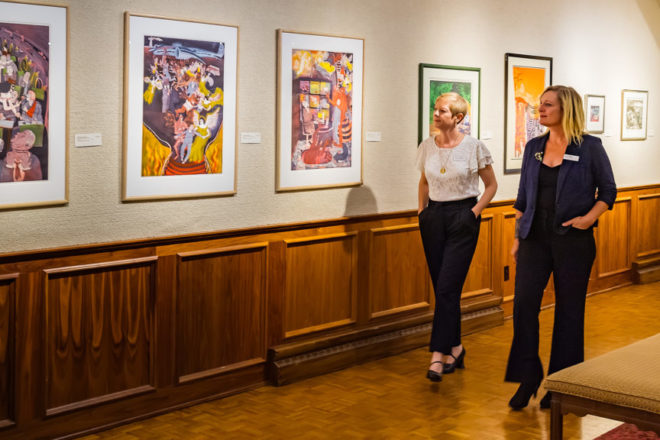How Does a Curator Choose Artists’ Work to Exhibit?
- Share
- Tweet
- Pin
- Share

For Helen del Guidice, being a curator in 2023 means spending plenty of time on Instagram. It’s a great way to find artists’ work to exhibit at Sturgeon Bay’s Miller Art Museum and to monitor “what other galleries are offering, who’s talking about what, who’s rising, who’s going stagnant,” she said.
When del Guidice scouring social media for artists’ work, she’s thinking about three main factors: installation logistics, the narrative of the art and its possible effect on the community.
Logistics come first. Some of the questions del Guidice asks herself include, “How much work does [the artist] have? Do they have enough to fill the space? Do they have enough cohesive work that’s going to tell the story we’re trying to tell? Can we arrange transportation, or will that be problematic?”
After working out these details, del Guidice looks for a throughline in the art itself: a cohesive narrative that she’ll be able to convey to museum-goers.
And she wants the museum as a whole to feel cohesive, too. That’s why she and other faculty members select a subtle theme for the exhibits each year. This year’s theme, Dynamics of Vision, shines through in the titles of some of the upcoming exhibits, including Horizon Line for works by Robert David Jinkins, Expanding Perspectives for works by Mauree Childress and Blind Spot for Suzanne Rose’s work.
The final consideration for del Guidice is how the art might affect Door County.
“Are there artists out in the community that I know would be inspired by this particular thing?” she asks herself. “Would this bring families together, like the [recent] Topelmann show?”
Once del Guidice selects the work of artists that she thinks would be a good choice for the Miller, she talks to the artists to gauge whether they’d be a good fit.
She also consults with her Miller colleagues to make sure everyone’s on board – or to change plans if that’s not the case.
“Sometimes, there’s something I find really engaging that maybe the rest of the team doesn’t think is that interesting,” del Guidice said.
After everyone agrees on an artist, they ask the artist whether he or she is interested. (At that point, del Guidice said, she and the artist have already been in contact for a while, so the answer is usually yes.) They then negotiate a contract to determine who’s responsible for which parts of the exhibition.
“The next part of the process for me is looking over the body of their work and deciding which pieces will fill the gallery in the most appropriate way and tell the best story,” del Guidice said.
A writing process follows, during which she seeks to express in words the story that the art is telling. This usually involves the artist’s thoughts, her own perspective and any context that’s necessary or helpful for viewers to understand the art.
“As a curator, part of my job is to negotiate what’s said about the paintings between the artist and the viewer,” del Guidice said. “The artist may have an experience that the viewer can’t relate to, so it’s up to me to sort of bridge that gap.”
In a typical year, she has four guest exhibits to coordinate, but this year, the museum is using both of its levels, making it eight shows to coordinate.
Her goal is to plan the Miller’s exhibits two years out, but like the rest of the world, the art world is always changing. So, sometimes her plans must change with it.
“It’s always a bit of a puzzle,” del Guidice said. “I always say that putting up an exhibition is an organic process, because no matter how much planning you do, there’s always going to be something that you didn’t anticipate.”




